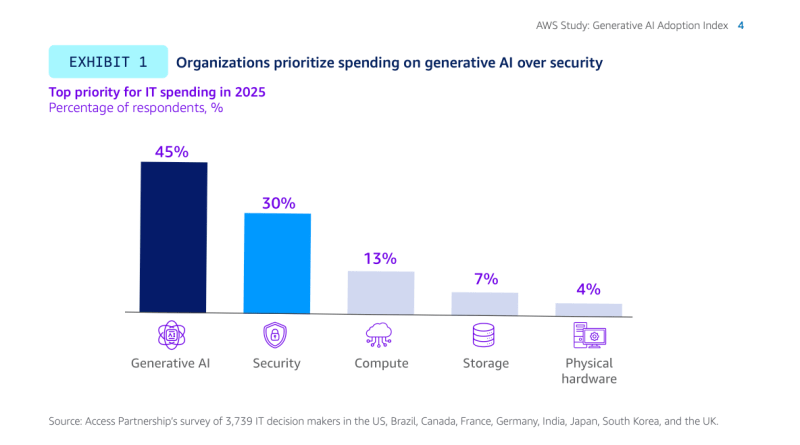Generative AI Takes Center Stage in IT Budgets for 2025
A comprehensive new study released by Amazon Web Services has revealed that generative AI tools have become the top budget priority for global IT leaders heading into 2025, surpassing cybersecurity investments. The AWS Generative AI Adoption Index surveyed 3,739 senior IT decision-makers across nine countries, uncovering a significant shift in corporate technology strategies.
Key Findings: AI Adoption and Budget Priorities
The study shows that 45% of organizations plan to prioritize generative AI spending over traditional IT investments like security tools (30%). This shift is driven by the broad need to accelerate AI adoption, according to Rahul Pathak, Vice President of Generative AI and AI/ML Go-to-Market at AWS. “Customers are seeing so many use cases for AI,” Pathak explained in an exclusive interview with VentureBeat.

The survey reveals that generative AI adoption has reached a critical inflection point, with 90% of organizations now deploying these technologies in some capacity. More tellingly, 44% have already moved beyond the experimental phase into production deployment.
Leadership and Talent Challenges
As AI initiatives scale across organizations, new leadership structures are emerging. The report found that 60% of organizations have already appointed a dedicated AI executive, such as a Chief AI Officer (CAIO), with another 26% planning to do so by 2026. However, nearly one-quarter of organizations will still lack formal AI transformation strategies by 2026, suggesting potential challenges in change management.
Organizations conducted an average of 45 AI experiments in 2024, but only about 20 are expected to reach end users by 2025. Talent shortages were identified as the primary barrier to transitioning experiments into production, with 55% of respondents citing the lack of a skilled generative AI workforce as their biggest challenge.

To address the skills gap, organizations are pursuing dual strategies of internal training and external recruitment. The survey found that 56% of organizations have already developed generative AI training plans, with another 19% planning to do so by the end of 2025. A significant 92% of organizations plan to recruit for roles requiring generative AI expertise in 2025.
Hybrid Approach to AI Implementation
The debate over whether to build proprietary AI solutions or leverage existing models appears to be resolving in favor of a hybrid approach. Only 25% of organizations plan to deploy solutions developed in-house from scratch, while 58% intend to build custom applications on pre-existing models and 55% will develop applications on fine-tuned models.

Regional variations in adoption rates were also observed, with India leading at 64% and South Korea at 54%, outpacing Western markets. The U.S. showed 44% of organizations prioritizing generative AI investments, aligning with the global average of 45%.
External Expertise and Future Outlook
The report found that 65% of organizations will depend on third-party vendors to some extent in 2025, with 15% planning to rely solely on vendors and 50% adopting a mixed approach combining in-house teams and external partners.

Pathak emphasized the importance of acting now: “Customers should be leaning in, or they’re going to risk getting left behind by their peers who are. The gains that AI can provide are real and significant.”
The study paints a portrait of generative AI’s rapid evolution from cutting-edge experiment to fundamental business infrastructure. Successful implementations will likely come from organizations that maintain a relentless focus on business outcomes rather than technological novelty. As Pathak noted, “AI is a powerful tool, but you got to start with your business objective. What are you trying to accomplish as an organization?”


